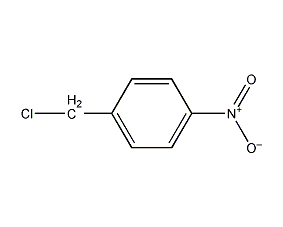p-nitrobenzyl chloride p-nitrobenzyl chloride


Structural formula
| Business number | 02H9 |
|---|---|
| Molecular formula | C7H6ClNO2 |
| Molecular weight | 171.58 |
| label |
1-(Chloromethyl)-4-nitrobenzene, 4-nitrobenzyl chloride, p-nitrobenzyl chloride, p-Nitrobenzyl chloride, p-nitrobenzyl chloride, 4-Nitrobenzyl chloride, 4-nitrobenzyl chloride, p-Nitrophenylmethane chloride, O2NC6H4CH2Cl, 4-Nitrobenzyl chloride, a-Chloro-4-nitrotoluene, A-Chloro-p-nitrotoluene, Alpha-Chloro-4-nitrotoluene, alpha-Chloro-p-nitrotoluene, AKOS BBS-00003951, 1-(Chloromethyl)-4-nitro-benzen, 1-(Chloromethyl)-4-nitrobenzene |
Numbering system
CAS number:100-14-1
MDL number:MFCD00007374
EINECS number:202-822-7
RTECS number:XS9093000
BRN number:387187
PubChem number:24886520
Physical property data
1. Properties: White needle-like crystals with tear-inducing properties.
2. Density (g/mL, 20℃): Undetermined
3. Relative vapor density (g/mL, air=1): Undetermined
4. Melting point (ºC): 71
5. Boiling point (ºC, normal pressure): Undetermined
6. Boiling point (ºC, 0.6mmHg): 112
7. Refractive index: Undetermined
8. Flash point (ºC): Undetermined
9. Specific rotation (º): Undetermined
10. Autoignition point or ignition temperature (ºC): Not determined
11. Vapor pressure (mmHg, ºC): Not determined
12. Saturated vapor pressure (kPa , ºC): Undetermined
13. Heat of combustion (KJ/mol): Undetermined
14. Critical temperature (ºC): Undetermined
15 . Critical pressure (KPa): Undetermined
16. Log value of oil-water (octanol/water) distribution coefficient: Undetermined
17. Explosion upper limit (%, V/V ): Undetermined
18. Lower explosion limit (%, V/V): Undetermined
19. Solubility: Insoluble in water, soluble in ethanol, ether, easily soluble in Acetone, benzene.
Toxicological data
1. Acute toxicity: rat oral LD50: 1809mg/kg; Inhalation of LCLo in rats: 280mg/m3/4H; 2. Other multiple dose toxicity: rat inhalation of TCLo: 20mg/m3/6H/2W-I; 3. Mutagenicity: Mutant microbial test: bacteria – Salmonella typhimurium, 5μg/plate; Mutant microorganism test: bacteria-Salmonella typhimurium, 100μg/plate; DNA repair test: Bacillus subtilis, 50μg/disc; Sister chromatid exchange test: hamster ovary, 100μmol/L;
Ecological data
This substance is harmful to the environment, and special attention should be paid to the pollution of water bodies.
Molecular structure data
1. Molar refractive index: 42.56
2. Molar volume (cm3/mol): 128.9
3. Isotonic specific volume (90.2K ): 338.0
4. Surface tension (dyne/cm): 47.1
5. Dielectric constant:
6. Dipole moment (10-24cm3):
7. Polarizability: 16.87
Compute chemical data
1. Reference value for hydrophobic parameter calculation (XlogP): None
2. Number of hydrogen bond donors: 0
3. Number of hydrogen bond acceptors: 2
4. Number of rotatable chemical bonds: 1
5. Number of tautomers: none
6. Topological molecule polar surface area 45.8
7. Number of heavy atoms: 11
8. Surface charge: 0
9. Complexity: 138
10. Number of isotope atoms: 0
11. Determine the number of atomic stereocenters: 0
12. Uncertain number of atomic stereocenters: 0
13. Determine the number of chemical bond stereocenters: 0
14. Number of uncertain chemical bond stereocenters: 0
15. Number of covalent bond units: 1
Properties and stability
Avoid contact with humid air, and avoid contact with alkali, amines, strong oxidants, water, and carbon dioxide.
Storage method
Store in a cool, dry, well-ventilated warehouse. Keep away from fire and heat sources. Keep container tightly sealed. They should be stored separately from oxidants, alkalis, etc. and avoid mixed storage. Equipped with the appropriate variety and quantity of fire equipment. Suitable materials should be available in the storage area to contain spills.
Synthesis method
None yet
Purpose
Used as chemical reagents and in organic synthesis.
